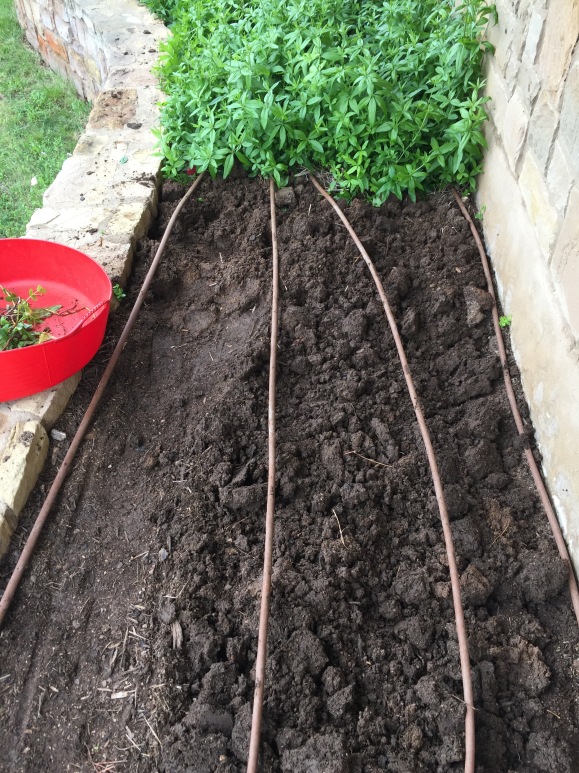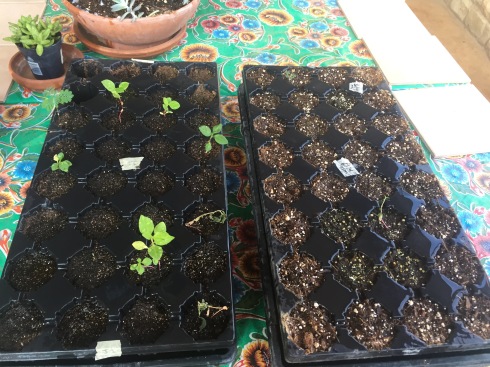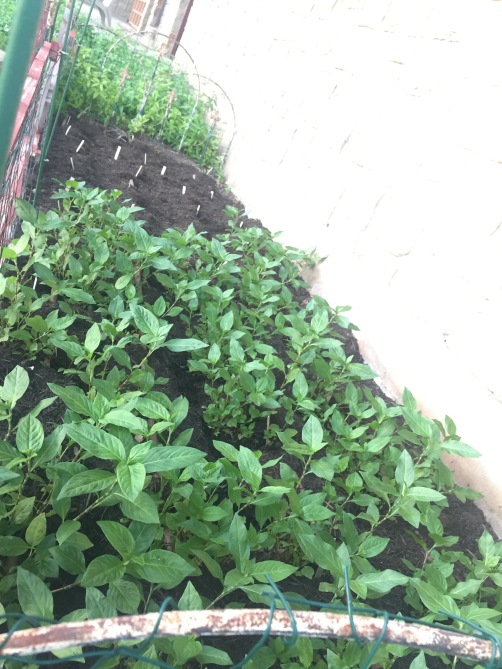Sometimes life or armadillos get in the way of gardening. Throw in seed misfires and you have to work on acceptance and rework with reality.
I am participating in an indigo study project (link) and was ready to start my spring garden. http://johnmarshall.to/TSG/TadeaiStudyGroup.htm
So when I asked John Marshall, my group coordinator, for the test seeds I was very early as he was still suffering thru late frosts and had not thought about seedlings yet. So my seeds would be in the mail soon but not yet. No worries, I had my own seeds to prep.
Here in my part of the Hill Country starting a garden involves indigo seed pack trays in late March. One cannot plant direct into the garden as we have crickets that are born hungry once they hatch when the earth gets warm. So you hold your plants in a protected area until after the cricket hatchlings have grown up and moved on. No problem, I started my own seeds for both Japanese Indigo and Indigo Suffruticosa. These grew happily in their bug safe area and I rotated them in the sun to harden them and strengthen the seeds.

I plant both Japanese Indigo and Indigo Suffruticosa, just for info here is a comparison of those seedlings and why I label my trays. Not much visual difference in the seedlings at the beginning.
My problems started when I prepped my indigo beds. I broke the earth and worked in more soil. By the end of the growing season the irrigation lines do a little dance and get out of line when they run so I always reset them in the soil and anchor them so they don’t dance early in the season. As I let them run to check for leaks I mark where the drip hole is so that I can drop in my seedlings where they get the best water. It’s not tough but is time consuming to turn the earth, place the markers and clean out the clay balls that turn up when you till. Here you can also see my madder root at the top of the photo. This has to be trimmed back and roots pulled to keep the madder root in its place. Or attempt to keep the madder root in its place.
 So you can imagine my muttering when I came out the next day ready to drop the plants in the prepared bed and either an armadillo, skunk or raccoon had come out to help me in my garden. All the lines were pulled up and holes dug randomly thru the bed. After serious grumbling I put out the live trap for a week and kept rotating my indigo seedlings in their safe room. Note my white markers that I carefully put by my drip hose have been tossed around. Plus holes dug everywhere, if I could only harness that energy.
So you can imagine my muttering when I came out the next day ready to drop the plants in the prepared bed and either an armadillo, skunk or raccoon had come out to help me in my garden. All the lines were pulled up and holes dug randomly thru the bed. After serious grumbling I put out the live trap for a week and kept rotating my indigo seedlings in their safe room. Note my white markers that I carefully put by my drip hose have been tossed around. Plus holes dug everywhere, if I could only harness that energy.

Well, the damn varmint just came coming back and digging and succeeding in tipping out the food without tripping the trap. Yes, I know if we had dogs we would not have these critter issues. I am just not a dog person. I was running out of time due to some travel plans so I constructed Fort Indigo. A combination of old lattice frames, gates and garden wire. I reset the garden prep and watched it for another week to see if that would stop the digging. Whoever did try to get in and wandered thru the outside madder root but my small fort seemed to hold them at bay.
So I dropped my seeds into place by the drip irrigation water outlets and moved forward. Half of the Japanese Indigo bed was my indigo seed I receive about 5 years ago from Donna Hardy, Sea Island Indigo, in the southern part of the US that I have faithfully renewed my seeds each season. Half of the bed was reserved for my project seeds that I received and started later in the month. In keeping with the “it’s a bad year for gardening”, only 5 seeds germinated out of two 24 seed tray, so much for my project participation with this round of indigo seedlings.

I have no explanation as to why these seeds did not germinate. It is the same seed starter soil, the same environment and watering sequence. Zip, nada but a few seedlings in the starter trays. In addition, I direct sowed extra seeds to see if I could jumpstart the project. Not one sprouted, either in the direct prepped bed or the starter trays.
The other item we considered is that I received older seeds from a prior year stock. It happens to the best gardeners. Japanese Indigo seeds are only viable for one year so it is entirely possible I got a batch from a prior year harvest since I started earlier than John expected. So….I am going to try again with what we know is this year’s seeds and do a late season harvest if I can get them up and going before an October freeze. At a minimum I do have my own Japanese Indigo growing so I will have some to dry for use later in the season.

One must have hope as a gardener. And practice acceptance. Blue will come again.
Proof of prior success, but failure in the garden happens. If all else fails, there is always weeds to pull!







Good to hear from you but sorry about the critter roaming around your neck of the country. I was just up your way last week with 5 grands. Visited a friend who has a small farm in J. City. We went to the Science museum, It is really interesting. I am in Phoenix, tried to Dye with some Eucalyptus, ( brought a small steamer) that I foraged, but I didn’t get very good color. Bonnie Davis
Sent from my iPhone
LikeLike
Hey Bonnie, sorry to hear about the eucalyptus adventure, maybe next time will work. I know you have had success before!
LikeLike
I do love this story Deb. I do hope you get enough of a crop of indigo for all your needs and some play too.
LikeLiked by 1 person
Thanks, one can learn from failure, she says hopefully. You’ll appreciate the fact that I am having bad issues with my back so redigging and resetting the garden was not only frustrating but painful. I’ll have surgery in October so hopefully the spare parts will last me well into old age. I am thankful for the dried indigo process. That late season indigo will be waiting for me on the other side of surgery.
LikeLike
Thanks for sharing! Gardening is like that sometimes. Circumstances did not allow me to plant a garden or any indigo this year. I am interested in the study group also, if you will be doing it next year.
LikeLike
Yes, I thought it would be good to blog about failure as well as success. Sometimes you just can’t hit the garden lottery of weather, time & opportunity. Follow the link to John’s blog. It is his study group….
LikeLike
I’ve never heard of Indigo Suffrucitosa. Do you dye with it in the same way as the Japanese–with either a reduce or fructose? Nice that it’s a perennial.
LikeLike
Yep, either way, here ya go.
http://www.cabi.org/isc/mobile/datasheet/28611
LikeLike